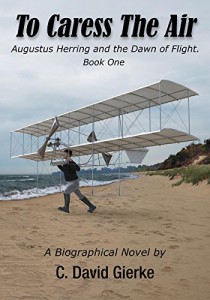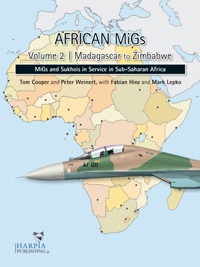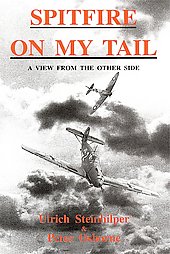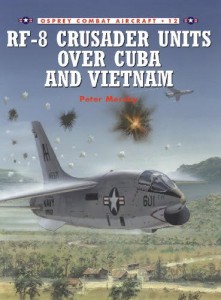210th Review RF-8 Crusader Units over Cuba and Vietnam- Peter Mersky
Growing up in the late ‘60s, in the jet age, I was always dazzled by the aerodynamic and streamlined beauty of jet airplanes, both commercial and military. The Vought RF-8 Crusader intrigued me, for the first thing any young boy noticed about that aircraft is the large, gaping engine intake under the cockpit. This is why many people call this aircraft the “gator.”
The Vought F-8 Crusader has the distinction of being the last jet fighter to have a 20mm cannon, in addition to sidewinder missiles, as its armament. This is also why the F-8 is referred to as the “last of the gunfighters.” In 1956, an F-8 flown by US Navy pilot R. W. Windsor reached a speed of 1,015 mph. The following year, the future astronaut, John Glenn, broke a record by flying from California to Brooklyn, New York in three hours, 23 minutes, and 8.4 seconds at a speed of 725.55 mph.
Glenn was interested in displaying the extended capability of the Pratt & Whitney J-57 engine under duress. He called his flight Project Bullet because he was to fly faster than the bullet of a .45 bullet pistol.
Peter Mersky brings the Crusader to life in RF-8 Crusader Units Over Cuba and Vietnam. While the F-8 Crusader was initially a fighter-escort aircraft, it was later converted into a reconnaissance airplane. The F-8 was eventually re-named RF-8, when it undertook its reconnaissance duties. The latter airplane is the focus of Mersky’s fine book.
The photo-reconnaissance RF-8 Crusaders had an impressive array of cameras that were mounted in different areas of the aircraft. Intelligence gathering was the role of these unarmed Crusaders.
No other mission was more historically significant for the RF-8 Crusader and its pilots than the reconnaissance flights over communist Cuba during the Cuban Missile Crisis of October 1962. While many aviation books cover different airplanes in war, Mersky’s book does a good job in describing the role of the RF-8 photo-intelligence gathering of the Soviet Union’s placing intermediate-range ballistic missiles (IRBMs) in Cuba. Even though, the high-flying U-2 had already photographed the Soviet missile installations in Cuba, low-level observation was necessary to confirm the existence of the missile sites. This is where the RF-8 Crusader proved invaluable.
The RF-8 Crusader’s reconnaissance missions over Cuba were billed as operation Blue Moon. Originally, the missions consisted of six RF-8s overflying three targets. Two Crusader’s were assigned to each missile site. Between October 23, 1962 and June 5, 1963, Marine and Navy pilots flew missions over the heavily defended missile sites. Mersky cites the dates of these flights and the units that flew them. Some of the photo-reconnaissance flights over the Soviet missile sites in Cuba were as low as 200 ft.
Photo-reconnaissance missions over Cuba were brutally dangerous because the newly installed totalitarian communist regime of Fidel Castro was not about to relinquish its absolute control over the communist island. Major Rudolf Anderson was killed when his U-2 was shot down over Cuba by a Soviet-made missile.
The Soviet missile sites in Cuba were defended by MIG-21, antiaircraft guns and SAM defenses. After the completion of each mission the pilots of the RF-8 painted a dead chicken on the fuselage of their Crusaders. This signified Castro’s “chickens coming home to roost.”
After Nikita Khrushchev was forced by President Kennedy to remove the Soviet missiles from Cuba, the mission of the RF-8 turned to monitoring their removal. This required additional photo-reconnaissance. During the height of the Soviet Union’s military build-up in Cuba there were over 23,000 Soviet troops in Cuba. In addition, there were 24 SAM sites with 500 missiles; 104 MIG fighters, including 24 new MIG-21, 200 air defense radars, over 100 helicopters and four cruise-missile sites that contained 150 cruise.
President Kennedy personally decorated all the photo-reconnaissance units that flew over Cuba. The photographs that these pilots and their aircraft took were clear and detailed, and proved to be invaluable in President Kennedy’s resolve to force the Soviet Union to remove their missiles from Cuba, even though the American President was not successful in removing Soviet Stalinism from the Caribbean island.












Leave a Reply